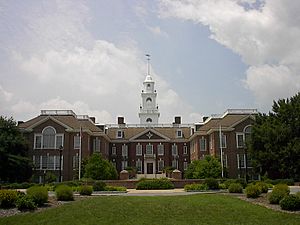Government of Delaware facts for kids

|
|
| Part of | United States of America |
|---|---|
| Constitution | Constitution of Delaware |
| Legislative branch | |
| Name | General Assembly |
| Type | Bicameral |
| Meeting place | Delaware Legislative Hall |
| Upper house | |
| Name | Senate |
| Presiding officer | Kyle Evans Gay, President |
| Lower house | |
| Name | House of Representatives |
| Presiding officer | Peter Schwartzkopf, Speaker |
| Executive branch | |
| Head of State and Government | |
| Title | Governor |
| Currently | Matt Meyer |
| Appointer | Election |
| Cabinet | |
| Leader | Governor |
| Deputy leader | Lieutenant Governor |
| Headquarters | Delaware Legislative Hall |
| Judicial branch | |
| Courts | Courts of Delaware |
| Delaware Supreme Court | |
| Chief judge | Collins J. Seitz Jr. |
| Seat | Wilmington |
The Government of Delaware is how the US state of Delaware is run. It was set up by Delaware's 1897 constitution. Just like the US federal government, it has three main parts: the executive, the legislative, and the judicial. The Governor leads the executive part. The General Assembly makes the laws. The Supreme Court is the highest court in the state. Delaware is also divided into counties, cities, and school districts.
Contents
Executive Branch: Leading the State
The executive branch is in charge of carrying out the state's laws. It is led by the Governor of Delaware. The current governor is Matt Meyer, who started his term on January 21, 2025. The lieutenant governor is Kyle Evans Gay, who also took office in 2025. Other important leaders include the Attorney General Kathy Jennings, Treasurer Colleen Davis, Auditor Lydia York, and Insurance Commissioner Trinidad Navarro.
Each year, the governor gives a "State of the State" speech. This speech tells the legislature about how Delaware is doing.
Legislative Branch: Making Laws
The Delaware General Assembly is the group that makes laws for Delaware. It has two parts, which is called bicameral. These parts are the Delaware Senate and the Delaware House of Representatives. The Senate has 21 members called senators, and the House has 41 members called representatives.
The General Assembly meets at Legislative Hall in Dover. They usually start their meetings on the second Tuesday of January each year. Their sessions typically end by the last day of June. However, the Governor can ask them to meet for a special session at any time.
Members of both the Senate and House are chosen by voters. Elections happen on the Tuesday after the first Monday in November. Senators serve four-year terms, with about half of them elected every two years. Representatives serve two-year terms, and all of them are elected every two years. There are no limits on how many terms a person can serve.
With 62 seats, the Delaware General Assembly is one of the smallest state legislatures in the United States. The Senate has a special job: it approves judges and other people the governor chooses for state jobs. Delaware's legislature is also unique because it can change the state constitution without needing a public vote.
Judicial Branch: Interpreting Laws
The judicial branch is made up of the state's courts. These courts explain what the laws mean and decide if laws have been broken. The Delaware Constitution set up several important courts:
- The Delaware Supreme Court is the highest court in Delaware.
- The Delaware Superior Court handles major trials for both civil and criminal cases.
- The Delaware Court of Chancery mainly deals with disagreements between companies.
- The Family Court handles cases about families, like divorce and child custody.
- The Delaware Court of Common Pleas handles smaller civil and criminal cases.
There are also smaller courts like the Justice of the Peace Courts.
The Delaware Court of Chancery is very important for businesses. Many companies choose to be officially registered in Delaware. This is because the Court of Chancery and the Delaware Supreme Court are known for making clear decisions about corporate law. These decisions often give companies a lot of freedom in how they run their business. Because of this, Delaware is seen as a very business-friendly state.
Counties: Local Divisions
Delaware is divided into three counties. These are New Castle, Kent, and Sussex. Delaware has the fewest counties of any US state. Each county has its own local government, which handles things like land use and building rules. Many services that are handled by counties in other states, like courts and police, are managed by the state government in Delaware. This means the state government has a lot of power.


